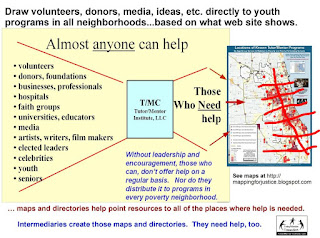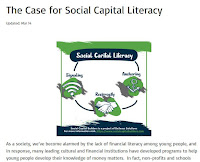Below is a graphic that I've been working on this past week. If you work your way through it I hope you'll have a better idea, and commitment, to the work that needs to be done in many places.
At the top of the graphic I show an arrow, that represents support all kids need, for the first 20-25 years of their lives, to help them through school and then, into and through their adult lives. Some kids, like Bill Gates, or Jeff Bezos, or Elon Musk, had much greater support propelling them to career success. Those are extreme examples, but most kids have a larger natural network of support than kids in high poverty areas.
That arrow comes from this "mentoring kids to careers" graphic, which I created in the late 1990s. It shows first grade through 12th grade, then college or vocational training, as a series of steps. At each step kids need a variety of different supports and/or are influenced by people who work in occupations that youth might aspire to in their own futures. If you open
this concept map, you'll see a different version of this timeline.
As I said above, all kids need some of these supports and influences. However, if you read many of the articles in
this section of my library, you'll see plenty of evidence showing that kids living in high poverty areas don't have as many naturally occurring supports or career models as do kids in more affluent areas. That means someone, or many people, need to help make these supports available and keep them in place for 12 or more years.
This leads to the next element on the graphic, which are the maps.
I've been using maps since 1993 to visually show areas of Chicago with high concentrations of poverty and many indicators showing kids and families need more help. Without a map you could have a long list of places you're helping, but still be missing a larger number of other places that need the same help.
You can find the maps shown above in
this article. You can find hundreds of articles on this blog, and the
MappingforJustice blog, showing similar maps and encouraging leaders to use them to guide resources into all of these areas for many years.
The map graphic I've used is a mashup of maps from three sources. In
this concept map you can find many data platforms that could be used to create similar map stories.
We see media using maps every day to show troop movement in Ukraine. Why can't we see similar maps showing the growth of youth and family support programs in every high poverty area of the USA?
My focus has been on helping long-term, volunteer-based tutor and/or mentor programs grow in all high poverty areas as a way of expanding the networks of support available to kids, helping them through school and beyond.
Thus, the arrow, or timeline, indicates multiple years of support. The map illustrates that many places need the same type of support for many years.
The graphic below visualizes the need for every industry to have strategies that distribute volunteers, technology, dollars and more into every neighborhood...and for school and non-school programs to be places where kids connect with a wider range of learning and career opportunities than might be normally available in their own family and neighborhood.
While I led a tutor/mentor program from 1975 through 2011, which collected inner city kids to a wide range of workplace adults, I did not start to understand this as a form of bridging social capital until the early 2000s.
Here's a link to one of the earliest articles that have influenced my thinking about social networks. One introductory paragraph says:“Social networks that can bridge across geography, race and class are key to success in the new economy”, says Professor Manuel Pastor, Jr., University of California, Santa Cruz, who has studied social networks in Los Angeles among Latinos. ‘Hard’ skills are essential, but it’s the connections and mentoring that provide information about what skills are necessary and a vision of how acquiring them can lead to new opportunities for all our residents”.This was written by Bob Pearlman. The research he points to can be found
at this link. His current website is
at this link.
Since then I've aggregated links to many articles about social capital, which you can
find here, and have posted
30+ articles on this blog that focus on social capital.
Here's a TED talk about expanding students' social capital -
click hereIn this article I point to an earlier influence. It was a book that I read in the mid 1990s, titled
American Apartheid: Segregation and the Making of the Underclass, by Douglas Massey. This book emphasized how disconnected people living in highly segregated, high poverty, neighborhoods were from the resources that might make lives in those communities better for residents.
I created
this presentation more than 20 years ago to show why organized tutor/mentor programs are needed in high poverty areas and actions the Tutor/Mentor Connection had piloted since 1993 to help such programs get the attention and resources each needs to constantly improve. The graphic I've included here visualizes some of the different types of learning, mentoring and tutoring that might take places in a site-based program.
These strategies have been based on the premise that areas of concentrated, high poverty, have too few people working in the wide range of careers that are modeled daily by parents, family and neighbors in more affluent places. Thus, such programs need to be built in order to expand the social capital for kids in poverty areas.
However.... that does not mean there are "no people" living in high poverty areas who have jobs and careers. That's the final element included in the graphic above. Kids and adults need to learn "who you already know" who might be someone who can mentor them and help open doors to opportunity.
This was emphasized in a social capital research webinar that I attended last Friday. The speaker was
Edward DeJesus, who leads a group called "
Social Capital Builders". He is teaching "social capital literacy" to businesses, organizations and young people.
I encourage you to read this
blog article by Edward, titled "The Case for Social Capital Literacy".
The need for social capital literacy is not really a new concept. Bob Pearlman's early 2000s article said, "Networking, or acquiring a social network, is a key skill of the 21st Century. It’s how you learn, and how you connect."
What I'm trying to emphasize is that these skills are not being taught in enough places and that programs like Social Capital Builders are trying to do that. If you're working with kids you should reach out to Edward and see if his lesson plans might be used in your own efforts.
Here's another version of the "hub and spoke" graphics shown above.
This shows how different industries could "distribute" learning and mentoring opportunities to kids in all high poverty areas, via school and non-school programs. Social capital literacy could be a separate box, or could be a part of the mentoring coming from each industry.
The map reinforces the need for these forms of learning and mentoring in EVERY high poverty neighborhood. The timeline emphasizes the need for such learning to be consistently available for many years. The other graphics emphasize that businesses in every sector could be supporting organized, volunteer-based tutor/mentor programs in multiple locations, not just one or two favored programs.
Let's look at the timeline arrow once more. If you click and enlarge it you'll see different types of learning activities that are appropriate for different age levels.
Here's another quote from Bob Pearlman's article:
"But the most significant finding in the study was that a student's social network can have a significant impact on his/her career choice. Students whose parents are both in high-tech careers are more likely to be interested in technology careers themselves. In addition, 83 percent of students rely on personal connections for career-related information and guidance."I believe that the earlier a young person becomes involved in a well-organized, mentor-rich non-school program, the more benefit that program will have. Stronger bonds will be built with mentors, and with the program itself. That's important because while a volunteer might leave after a year or longer, the program's ability to provide continuity, and a replacement mentor, helps keep the youth involved. As a youth moves from middle school to high school the support offered can lead to part time jobs, internships, college access, scholarships and ultimately job and career opportunities.
The type of mentoring and social capital literacy Edward DeJesus teaches depends on the maturity and motivation of the mentee. This is true with most forms of workplace mentoring that I've looked at.
Kids in primary school where fundamental learning habits can be reinforced, and career aspirations nurtured, don't yet have that level of maturity. However, by middle school, and early high school, I think most kids would be ready to take more control over their own futures, if there were people helping them.
We need to make that happen.
This has been a long post. Thanks for reading. I hope we connect on Twitter, Facebook, Instagram and/or LinkedIn.
If you want to support my work, please visit this page and use PayPal to send a contribution.


































